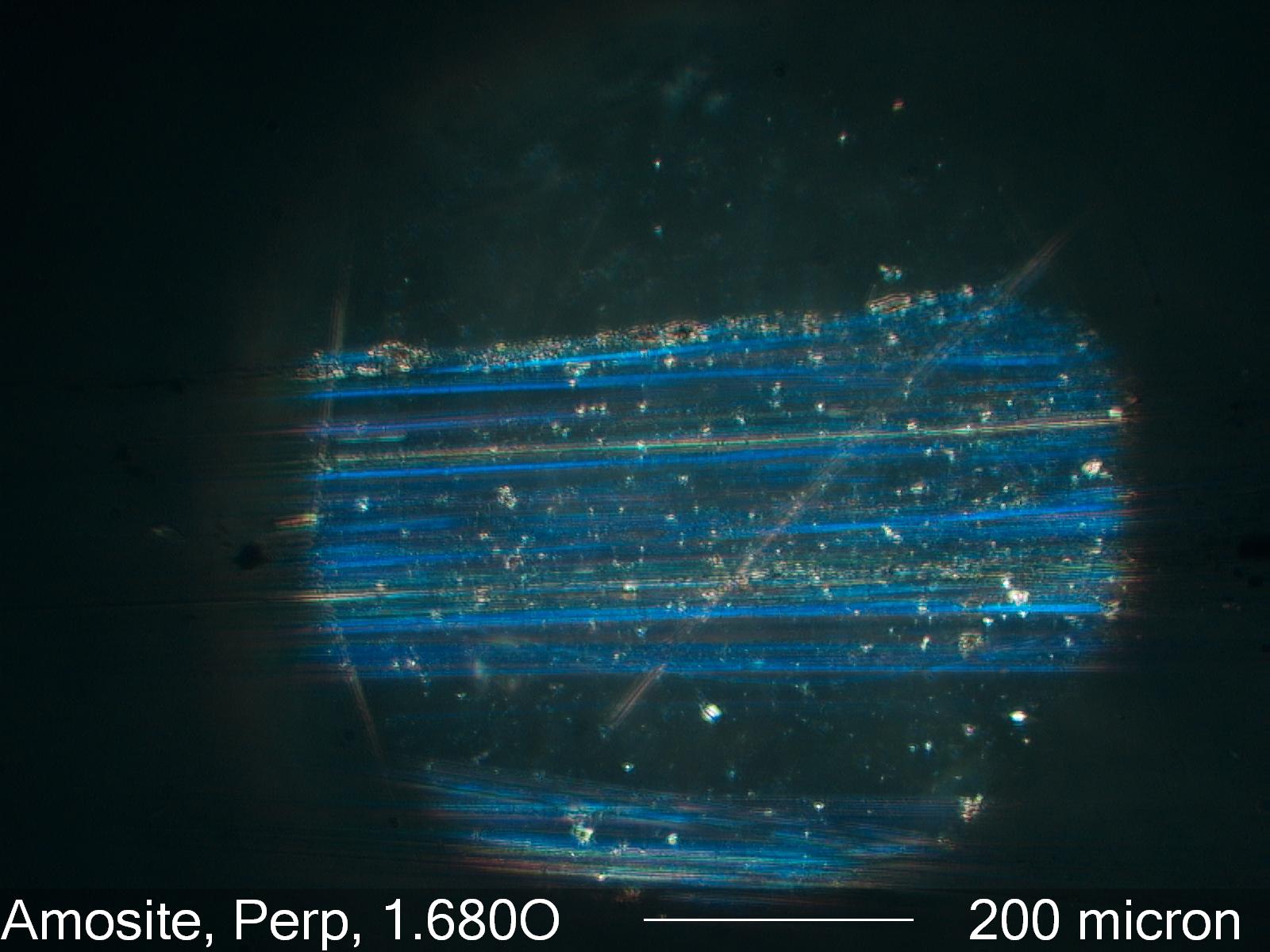Amosite Asbestos, Objective Central Stop Dispersion Staining
The D-line refractive index across the width of this sample of amosite asbestos is about 1.675. It matches the refractive index of the Cargille High Dispersion 1.680 liquid at a wavelength of about 650 nanometers. At this wavelength the Cargille liquid has a refractive index of about 1.671, as does the amosite. This Type of Dispersion Staining produces a single color for any given wavelength match between a given liquid and solid with a fixed single linear polarizing filter. Objective central stop dispersion staining produces the same colors as condenser cental stop dispersion staining but the depth of field is greater and much of the resolution of the particles is lost. As a result it is more difficult to associate the dispersion colors with the particles that are producing the effect in fields of view that are layered with particles.
Transmitted Objective Central Stop Dispersion Staining, Single Polarizing Filter
Perpendicular to Length
Amosite asbestos was used primarily for boiler and steam pipe insulation and for sound proofing products like acoustic ceiling tile. It is not a common form of amphibole and so its presence in the environment generally indicates the disturbance of an asbestos containing construction material.
When used in acoustic ceiling tile it is generally mixed with glass fiber and an epoxy binder.
2. Campbell, W.J., R.L. Blake, L.L. Brown, E.E. Cather, and J.J. Sjoberg, IC 8751; SELECTED SILICATE MINERALS AND THEIR ASBESTIFORM VARIETIES, US Dept. of the Interior, Bureau of Mines Information Circular, 1977
3. Deer, W. A., R. A. Howie, and J. Zussman, AN INTRODCUTION TO THE ROCK-FORMING MINERALS, ISBN 0-582-30094-0, pp. 237-241, 1992
4. Ledoux, R. L. (ed), SHORT COURSE IN MINERALOGICAL TECHNIQUES OF ASBESTOS DETERMINATION, Mineralogical Association of Canada, 1979.
5. Levadie, Benjamin (ed), DEFINITIONS FOR ASBESTOS AND OTHER HEALTH-RELATED SILICATES, ASTM STP 834, 1984.
6. Riordon, P. H. (ed), GEOLOGY OF ASBESTOS DEPOSITS, Society of Mining Engineers, 1981.
7. World Health Organization, ASBESTOS AND OTHER NATURAL MINERAL FIBRES, Environmental Health Criteria 53, 1986.
Definition/Function:
Amosite asbestos is the fibrous form of amphibole in the cummingtonite-grunerite family. Its chemical composition is (Mg, Fe, Mn)7[Si8O22](OH) 2. It is the next most common commercial asbestos after Chrysotile.Significance in the Environment:
Amosite is a hazardous material and exposure should be very carefully limited. It is one of the more hazardous of the asbestos minerals.Amosite asbestos was used primarily for boiler and steam pipe insulation and for sound proofing products like acoustic ceiling tile. It is not a common form of amphibole and so its presence in the environment generally indicates the disturbance of an asbestos containing construction material.
Characteristic Features:
Amosite fibers tend to be straight and are rather stiff. The fibers tend to be bundles and the terminations are often Well broomed. They show good dispersion colors when dispersion staining is used and they are mounted in a high dispersion 1.680 refractive index oil.Associated Particles:
The two most common non-fibrous materials that amosite is associated with are magnesia and gypsum. A very common block form of insulation containing amosite was simply designated as Magnesia 80. It is 80% magnesia (magnesium oxide) and 20% asbestos. The asbestos content ranges from 20% amosite to various blends of amosite and chrysotile. The gypsum formulation was similar though often calcite (limestone) would be blended into the gypsum.When used in acoustic ceiling tile it is generally mixed with glass fiber and an epoxy binder.
References:
1. Asbestos Textile Institute, HANDBOOK OF ASBESTOS TEXTILES, 3RD EDITION, 1967.2. Campbell, W.J., R.L. Blake, L.L. Brown, E.E. Cather, and J.J. Sjoberg, IC 8751; SELECTED SILICATE MINERALS AND THEIR ASBESTIFORM VARIETIES, US Dept. of the Interior, Bureau of Mines Information Circular, 1977
3. Deer, W. A., R. A. Howie, and J. Zussman, AN INTRODCUTION TO THE ROCK-FORMING MINERALS, ISBN 0-582-30094-0, pp. 237-241, 1992
4. Ledoux, R. L. (ed), SHORT COURSE IN MINERALOGICAL TECHNIQUES OF ASBESTOS DETERMINATION, Mineralogical Association of Canada, 1979.
5. Levadie, Benjamin (ed), DEFINITIONS FOR ASBESTOS AND OTHER HEALTH-RELATED SILICATES, ASTM STP 834, 1984.
6. Riordon, P. H. (ed), GEOLOGY OF ASBESTOS DEPOSITS, Society of Mining Engineers, 1981.
7. World Health Organization, ASBESTOS AND OTHER NATURAL MINERAL FIBRES, Environmental Health Criteria 53, 1986.


